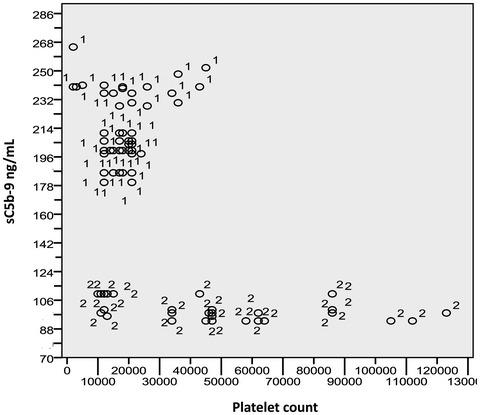当前位置:
X-MOL 学术
›
Clin. Exp. Immunol.
›
论文详情
Our official English website, www.x-mol.net, welcomes your feedback! (Note: you will need to create a separate account there.)
Complement activation in patients with immune thrombocytopenic purpura according to phases of disease course.
Clinical & Experimental Immunology ( IF 4.6 ) Pub Date : 2020-06-09 , DOI: 10.1111/cei.13475 R Castelli 1 , G Lambertenghi Delilliers 2 , A Gidaro 1 , M Cicardi 1 , L Bergamaschini 1
Clinical & Experimental Immunology ( IF 4.6 ) Pub Date : 2020-06-09 , DOI: 10.1111/cei.13475 R Castelli 1 , G Lambertenghi Delilliers 2 , A Gidaro 1 , M Cicardi 1 , L Bergamaschini 1
Affiliation

|
Immune thrombocytopenic purpura (ITP) is an autoimmune thrombocytopenia with shortened platelet survival and relative bone marrow failure. The pathogenesis involves antibody production, cytokine release, T cell impairment, complement activation and clearance of platelets. We measured plasma levels of C3, C4, C1q and sC5b‐9 in 80 ITP patients in acute phase, 50 ITP patients in complete (CR) or partial (PR) remission and 50 age‐ and sex‐matched healthy volunteers. Statistical analyses showed that acute ITP patients had higher plasma levels of sC5b‐9 and C1q than CR or PR patients (median = sC5b‐9: 200 versus 98 mg/dl, P‐value < 0·001) (median C1q = 2·11 versus 1·00 mg/dl, P‐value < 0·001). CR and PR ITP patients had sC5b‐9 and C1q plasma levels comparable to those observed in healthy volunteers. There was a significant correlation between sC5b‐9 and C1q plasma levels (Spearman’s rho correlation index on 130 ITP patients equal to 0·58, P‐value < 0·001). We also found that sC5b‐9 plasma level is inversely correlated with the number of platelets. Furthermore, we divided acute ITP patients into subjects with detectable (24 of 80, 30%) or undetectable (56 of 80, 70%) anti‐platelet antibodies; patients with detectable anti‐platelet antibodies have significantly higher plasma levels of C1q and sC5b‐9. This research will potentially offer novel therapeutic strategies in light of new drugs affecting complement activation for monitoring therapy response.
中文翻译:

根据病程阶段对免疫性血小板减少性紫癜患者进行补体激活。
免疫性血小板减少性紫癜(ITP)是一种自身免疫性血小板减少症,血小板存活时间缩短,骨髓相对衰竭。发病机制涉及抗体产生、细胞因子释放、T 细胞损伤、补体激活和血小板清除。我们测量了 80 名急性期 ITP 患者、50 名完全 (CR) 或部分 (PR) 缓解的 ITP 患者和 50 名年龄和性别匹配的健康志愿者的 C3、C4、C1q 和 sC5b-9 血浆水平。统计分析表明,急性 ITP 患者的 sC5b-9 和 C1q 血浆水平高于 CR 或 PR 患者(中位数 = sC5b-9:200 与 98 mg/dl,P值 < 0·001)(中位数 C1q = 2· 11与1·00 毫克/分升,P-值 < 0·001)。CR 和 PR ITP 患者的 sC5b-9 和 C1q 血浆水平与在健康志愿者中观察到的水平相当。sC5b-9 和 C1q 血浆水平之间存在显着相关性(130 名 ITP 患者的 Spearman's rho 相关指数等于 0·58,P值 < 0·001)。我们还发现 sC5b-9 血浆水平与血小板数量呈负相关。此外,我们将急性 ITP 患者分为可检测到(80 人中的 24 人,30%)或检测不到(80 人中的 56 人,70%)抗血小板抗体的受试者;可检测到抗血小板抗体的患者血浆 C1q 和 sC5b-9 水平显着升高。鉴于影响补体激活监测治疗反应的新药,这项研究可能会提供新的治疗策略。
更新日期:2020-08-12
中文翻译:

根据病程阶段对免疫性血小板减少性紫癜患者进行补体激活。
免疫性血小板减少性紫癜(ITP)是一种自身免疫性血小板减少症,血小板存活时间缩短,骨髓相对衰竭。发病机制涉及抗体产生、细胞因子释放、T 细胞损伤、补体激活和血小板清除。我们测量了 80 名急性期 ITP 患者、50 名完全 (CR) 或部分 (PR) 缓解的 ITP 患者和 50 名年龄和性别匹配的健康志愿者的 C3、C4、C1q 和 sC5b-9 血浆水平。统计分析表明,急性 ITP 患者的 sC5b-9 和 C1q 血浆水平高于 CR 或 PR 患者(中位数 = sC5b-9:200 与 98 mg/dl,P值 < 0·001)(中位数 C1q = 2· 11与1·00 毫克/分升,P-值 < 0·001)。CR 和 PR ITP 患者的 sC5b-9 和 C1q 血浆水平与在健康志愿者中观察到的水平相当。sC5b-9 和 C1q 血浆水平之间存在显着相关性(130 名 ITP 患者的 Spearman's rho 相关指数等于 0·58,P值 < 0·001)。我们还发现 sC5b-9 血浆水平与血小板数量呈负相关。此外,我们将急性 ITP 患者分为可检测到(80 人中的 24 人,30%)或检测不到(80 人中的 56 人,70%)抗血小板抗体的受试者;可检测到抗血小板抗体的患者血浆 C1q 和 sC5b-9 水平显着升高。鉴于影响补体激活监测治疗反应的新药,这项研究可能会提供新的治疗策略。



























 京公网安备 11010802027423号
京公网安备 11010802027423号